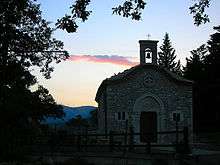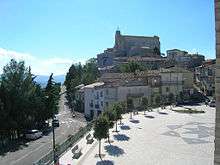San Giovanni Lipioni
| San Giovanni Lipioni | ||
|---|---|---|
| Comune | ||
| Comune di San Giovanni Lipioni | ||
|
San Giovanni Lipioni | ||
| ||
 San Giovanni Lipioni Location of San Giovanni Lipioni in Italy | ||
| Coordinates: 41°51′N 14°34′E / 41.850°N 14.567°E | ||
| Country | Italy | |
| Region | Abruzzo | |
| Province / Metropolitan city | Chieti (CH) | |
| Government | ||
| • Mayor | Angelo Di Prospero | |
| Area | ||
| • Total | 8.67 km2 (3.35 sq mi) | |
| Elevation | 545 m (1,788 ft) | |
| Population | ||
| • Total | 286 | |
| • Density | 33/km2 (85/sq mi) | |
| Demonym(s) | Sangiovannese | |
| Time zone | CET (UTC+1) | |
| • Summer (DST) | CEST (UTC+2) | |
| Postal code | 66050 | |
| Dialing code | 0873 | |
| Patron saint | St. Felice | |
| Saint day | August, 21st | |
| Website | Official website | |
San Giovanni Lipioni is a small village and comune located at the southernmost tip of Province of Chieti in the Abruzzo region of Italy, on a 545-metre (1,788 ft) hill overlooking the river Trigno valley.
History
The first settlement in the village presumably dates back to the pre-Roman times, when the area was under the control of the Samnites population. As an evidence of this is a III century B.C. bronze man's head discovered in the village countryside in 1847 and currently stored at the Bibliothèque Nationale de France.
Starting from the 14th century, the village was under the influence of the Kingdom of Naples through the Aragon and the D'Avalos families, of Spanish origin, which held possessions in the nearby coastal town of Vasto. The name Lipioni is thought indeed to be derived from the Spanish los peones (unskilled labourers), referring to the predominant peasantry condition and sheep-rearing activity of the village's inhabitants.[1]
Subsequently, until 1861 the village was under control of the Caracciolo families, always within the Kingdom of Naples territory.
Among the most important families of the village is nowadays the Rossi family, lawyers and medical doctors, owners of an important and ancient historical house. The building is now the focus of a judicial process between the heirs of the family.
Economy
The village essentially lives on agriculture like the neighbouring ones. The majority of the working population is employed in the sector, and production is geared towards local and family consumption. The main produces are wine and extravirgin olive oil (renowned outside the region for its quality), along with wheat, corn, cherries, apples, walnuts, almonds, artichokes, tomatoes, and peppers.

People
After the end of World War II, because of severe poverty and high unemployment, the village suffered a considerable emigration towards richer Northern Italy areas, especially in the town of Bologna, where a sizeable community live nowadays. A small number also migrated to Belgium, in the Charleroi area to work in the local coal mines, and France by subsequently settling there.
From around 900 units in 1951, the population halved to 457 in 1982, and down to 371 in 1991, according to official ISTAT statistics.[2]
In 2001 the total population plummeted to 271 units and as of 2006, the stable residents are less than 250, of which those aged 65+ account for half of the total.
Territory
The village lies at an elevation of 545 metres (1,788 ft). The territory's highest peaks are Colle Vernone, 717 metres (2,352 ft) overlooking the village, and the mountain Il Monte, 693 metres (2,274 ft), facing it. Oaks and beeches are the predominant trees, along with firs and pine trees. Olive trees are also quite widespread over the territory, followed by fig, apple and cherry trees. Bush vegetation includes several type of wild berries and yellow brooms blooming in mid-springtime. Fauna features increasing numbers of boars and foxes, owls, and a few EU-protected species of kites (Milvus milvus and Milvus migrans) that nest in the woods of Il Monte and its vicinity.[3]
The nearest villages are Torrebruna and Celenza sul Trigno at a distance of 7 kilometres (4 mi) each. The river Trigno separating Abruzzo from Molise runs in the valley beneath the village for 5.5 kilometres (3.4 mi).
Things to see

- The historical centre perched on the hilltop with its many old (some refurbished) hard-and-rough stone houses, the maze of tiny alleys, and the 17th-century church of Santa Maria delle Grazie, sitting at the top of a path of more than 200 steps starting from the pedestrianised main square Piazza Largo del Popolo.
- The historical house of Rossi family (Casa Madre), built in 1650, nowadays property of Rossi-Cianci family. Currently, the house is under restoration.
- The historical fountain, former owned by the local council, now property of Rossi-Cianci family, who bought it in 1960.
- The recently revamped small chapel of Santa Liberata, at the foot of Colle Vernone, with its adjoining small pinetree wood and picnic area, surrounded by pretty sights of the extensive olive tree fields and vineyards below, and the mountains around.
- Nearby, there's an imposing, tall, ancient oak called Quercia di Lozzi.
- The paved road from the village to Il Monte mountain makes for an easy 5-kilometre (3.1 mi) walking trail, offering views over the river Trigno valley. On a clear day, the Adriatic Sea can be spotted 29 kilometres (18 mi) to the northeast as well as the Maiella ridge, 50 kilometres (31 mi) northwest, and the Matese mountains, 47 kilometres (29 mi) southwest. A rest–picnic area with a spring water fountain known as Fonte del Trocco is found halfway before the road winds up through the thick oak wood up to the Il Monte top, when it unravels down through the fields. It then joins the main two-lane road SP202 leading to the village, 2.5 kilometres (1.6 mi) across Colle Vernone, with more sights of the hills and fields around.
Traditions and specialties

On Labour Day (May, 1st) a colourful pageant is held throughout the village's high streets to celebrate lu Maje (The May), a circle-shaped wooden cane decked with small bunches of wild pink underbrush violets and other spring flowers and carried at the forefront of the pageant, which kicks off at the main church soon after the late morning mass. The flowers are then gifted to all families of the village during the door-to-door parade. A marching band plays along while food-and-drinks stalls are set out on the streets.
In early August, when the village comes alive with expatriates, night-time food feasts (called sagre) are common. One of these is the sagn' app'zat (literally "sagnas cut into pieces"), which are freshly made, slightly thick pasta layers sliced into rough 5-by-5-centimetre (2 by 2 in) squares and eaten with a simple basil-and-tomato sauce, extra-virgin olive oil, and occasionally topped with lumps of ricotta cheese and/or bits of sliced spicy red chillies.
On every second Saturday of October, the food feast of the scurpelle—simple salted sourdough batons, 20 to 30 centimetres (8 to 12 in) long, deep-fried in olive oil and eaten as such, accompanied by a glass of new red wine—is made to celebrate Santa Liberata.
Another worth-mentioning specialty, also common to most villages in southern area of Chieti's province, is the ventricina, a usually round-shaped salami made of fresh pork finely chopped and mingled with bits of lard, ground dried red medium-spicy peppers, fennel seeds, and coarse salt, usually prepared during the colder winter days of January (after the first snow falls it is tradition to slaughter a pig), then hanged on the ceiling in a dry room and seasoned for usually 1+ months until ready to be sliced and served with freshly baked bread as an appetizer. At the same time, fresh pork sausages and pig liver sausages and several varieties of salami are prepared as well.
Trivia
The origins of the 2006 FIFA World Cup Italian scorer Fabio Grosso can be traced to the village, where his father was born and raised. His surname, along with Rossi and Monaco, is indeed quite common amongst the inhabitants.
External links
- Official website of the municipality of San Giovanni Lipioni (Italian)
- Bibliothèque Nationale de France - San Giovanni Lipioni III century B.C. bronze man's head
- San Giovanni Lipioni
Notes
- ↑ Picciani, Luciano (1995). San Giovanni Lipioni - Sulle Orme dei Padri . Tinari, Bucchianico (CH), page 65
- ↑ ISTAT (2007). Ricostruzione della popolazione residente, per sesso ed età nei comuni italiani. Anni 1982 - 1991. Comune: San Giovanni Lipioni. Available at: http://demo.istat.it/dat81-91/COMUNI/069/T_HTM/069080_T.HTM , visited on 04/02/2007
- ↑ WWF Italia - Abruzzo (2005). Impianto eolico a San Giovanni Lipioni (CH): il WWF chiede la valutazione di incidenza ambientale. Available at: http://www.wwf.it/Abruzzo/news/1962006_5513.asp; visited on 01/02/2007.

